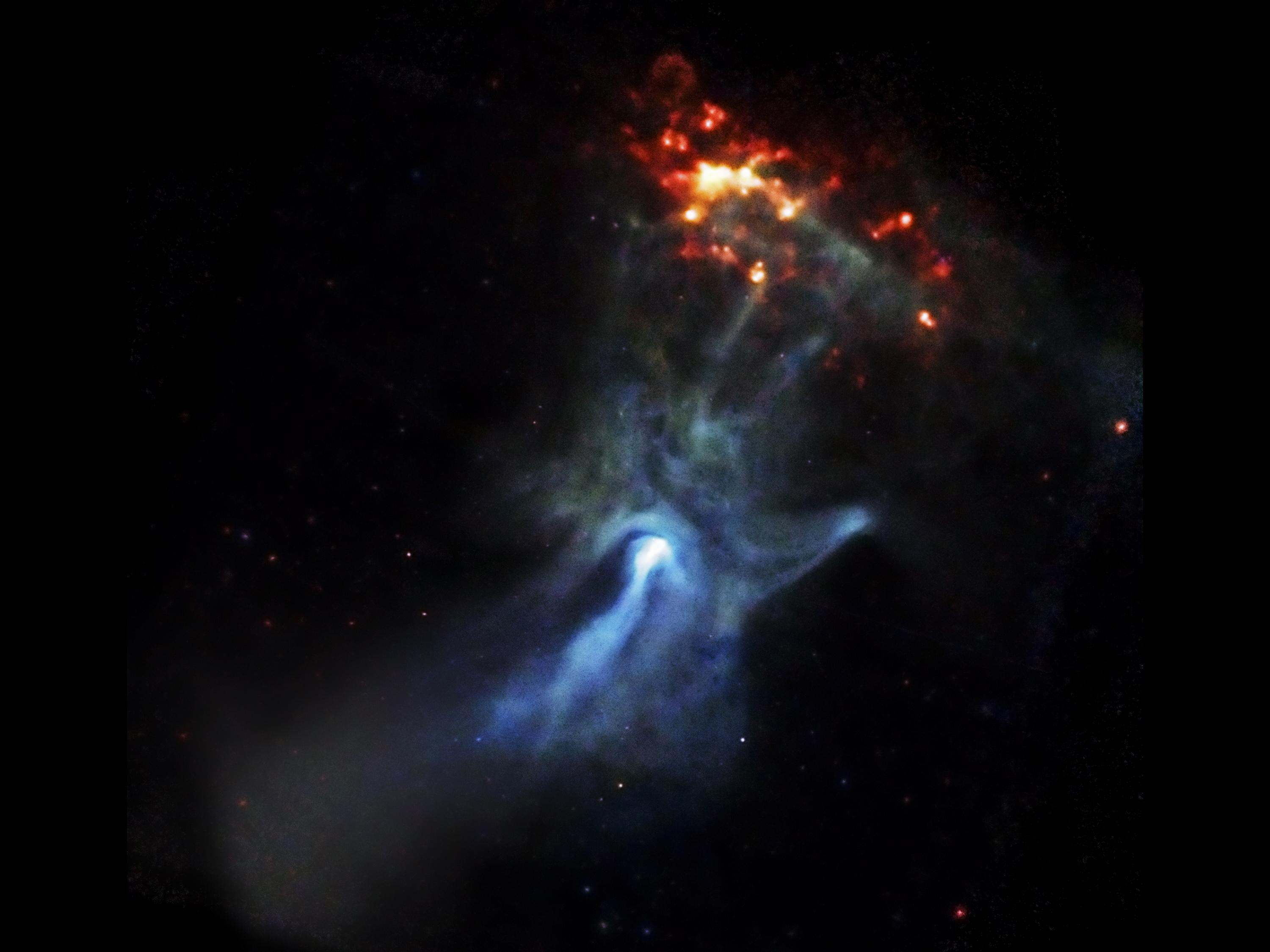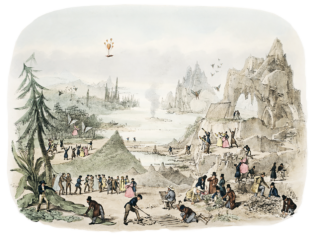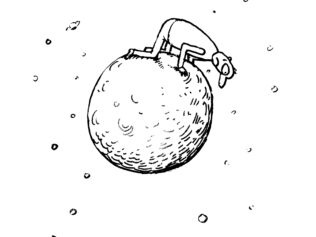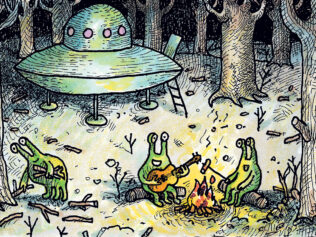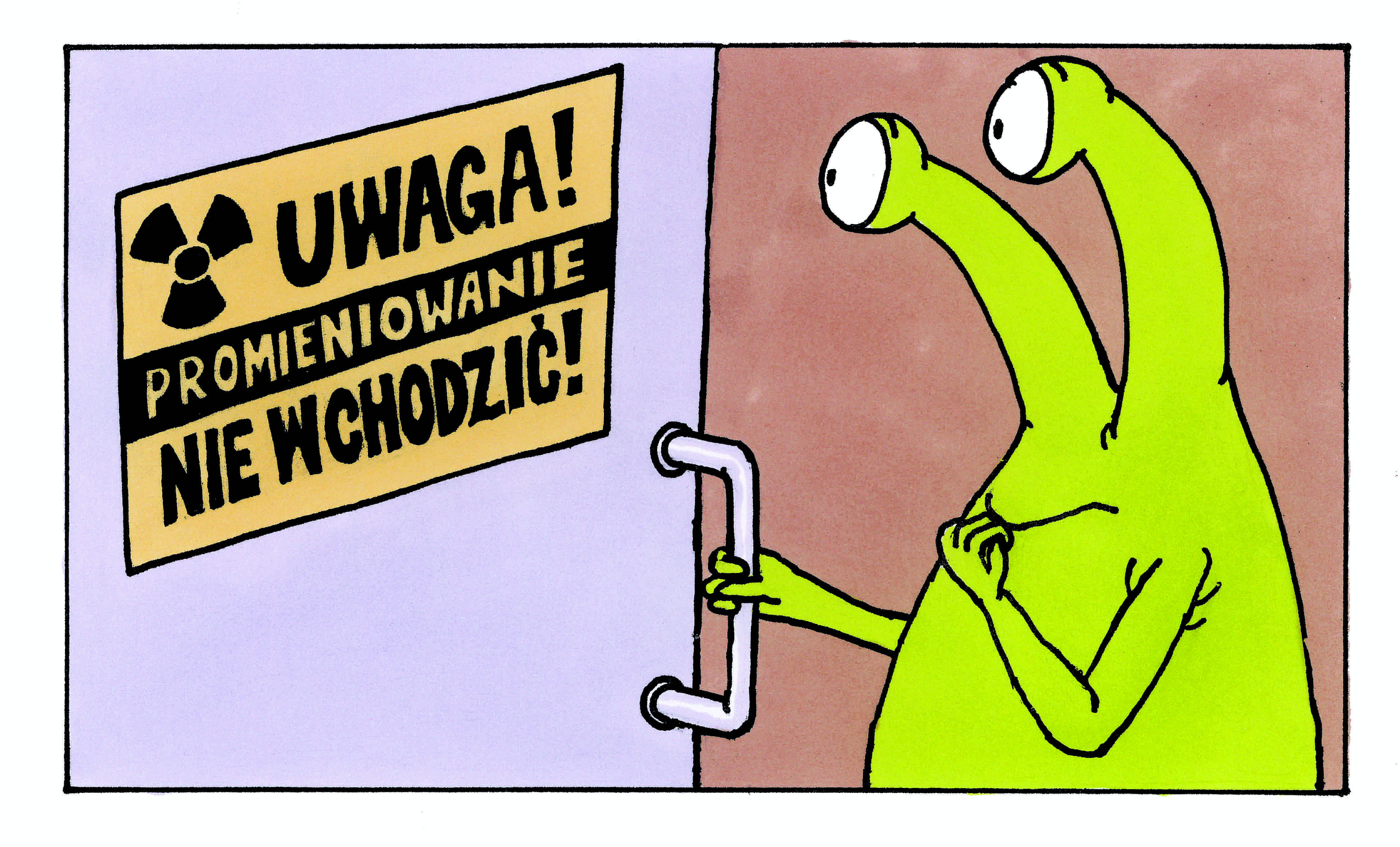
Here is a pulsar, PSR B1919+21, located in the constellation of Vulpecula. Despite remaining invisible to the eye, it sends out radio signals with perfect regularity, namely once every 1.337302088331 seconds. These powerful pulses race through space at the highest possible speed, namely 299,792,458 m/s. After 1000 years, some of them reach a small, bluish planet populated by the strangest of creatures, made of proteins.
And here is one of these imperfect, organic creatures: a young homo sapiens female in horn-rimmed glasses. She is walking between thin posts installed in the ground. There are around 1000 of them, and they form pairs linked by diagonal rods, with wire hanging between each pair. The area is somewhat reminiscent of a field prepared for the cultivation of hops. In fact, it is an experimental radio astronomy observatory at the University of Cambridge.
It is the year 1967, the sixth day of August, and this particular homo sapiens is called Jocelyn Bell. She has spent the past two years building a novel observatory together with other PhD students at the astronomy department at the University of Cambridge. She would put posts in the ground and string up wires and dipole antennas. Her colleagues have now found other occupations, whereas Jocelyn has been made responsible for maintaining the construction of the observatory and analysing the findings.
Jocelyn is going to the technical building, as she does every day, to analyse 100 feet of paper tape showing lines drawn by three pens. This is a record of the radio signals detected by the observatory. She manages to go through some of the results in the building and takes the rest home to the attic she rents with a friend. She will spend a long evening poring over the squiggly lines left by the pens.
Jocelyn has been doing this job for a few weeks, so she has learned to recognize what the peaks drawn on the tape mean. Some are the effect of interference from the Earth. Others come from space – when electromagnetic waves enter the Earth’s atmosphere, they start ‘twinkling’ (as does the light of stars visible from Earth).
On that evening, however, Jocelyn noticed a small bump that appeared to belong to a different, third category. What’s more, she recalled that she had seen a similar bump before, some 400 feet of tape earlier, when the radio telescope had been scanning the same patch of sky (the telescope was set up to scan the sky in cycles, making a complete scan in four days before returning to the starting point).
There was only one thing Jocelyn could do to inspect that peculiar signal more closely, namely to run the paper through the apparatus faster at the right moment to get a better quality record. She finally succeeded in doing so, but not until 28th November. That was when she noticed that the strange bumps repeated at regular intervals, around every 1.3 seconds. No astronomer had ever observed anything like this before.
***
Jocelyn immediately took the unusual findings to her research supervisor, Professor Tony Hewish, who had designed the telescope and overseen its construction. The device was intended to enable him to study quasars – star-like objects that emitted continuous radiation. The quick pulses detected by Bell were completely at odds with what he had expected. He concluded that they had to come from Earth, because nothing in space could send out such signals.
However, the facts were unrelenting. The signals reached the Earth according to sidereal time, which was different from solar time. Consequently, they must have come from a source other than Earth. Hence the suspicion that they might have been sent by an extraterrestrial civilization. The strange source was nicknamed LGM-1, after ‘little green men’.
Jocelyn later mentioned that she had paid Hewish an unexpected visit in his office around Christmas to discuss the details of the observations. Hewish and his colleagues from the astronomy department turned out to be having a meeting to decide how they should announce the shocking discovery to the public without creating panic. The doctoral student felt she was not being treated fairly: why had she not been invited to the meeting? However, she did not bother herself with that question too long. She kept doing her work, which involved analysing the output on paper tapes. She was the only person doing this – Hewish was not interested in such arduous work. Jocelyn thought that if she could find another similar source, she could possibly solve the puzzle.
Indeed, after looking through hundreds of feet of chart, she came across signals from another patch of the sky. Those signals were also very regular, but this time the period was 1.2 seconds. The discovery of a second source disproved the ‘little green men’ theory. However, it did not make the discovery any less sensational. What Jocelyn Bell had noticed on the first paper tape was a signal that heralded the existence of the first pulsar to be discovered by man: PSR B1919+21.
When the news was announced at a seminar in Cambridge, Fred Hoyle, a titan of British astronomy, was greatly impressed by the discovery. Jocelyn, in turn, was greatly impressed by Fred Hoyle, who, upon seeing the findings for the first time, immediately hypothesized that the source of the radio waves must be a neutron star (a supernova remnant). That hastily formulated hypothesis remains valid to the present day.
In February 1968, Hewish and Bell announced their discovery in Nature. In 1974, the discovery won the Nobel Prize in Physics. The most important prize in science was shared first of all by Tony Hewish, who designed the observatory; second by Martin Ryle, a pioneer of radio astronomy and undoubtedly a very accomplished scientist; and third and most importantly, by no one else. The person who discovered pulsars, Jocelyn Bell (now Jocelyn Bell Burnell), did not receive the prize.
Fred Hoyle believed that this was a serious mistake. But Jocelyn did not complain. She was young, she was Northern Irish, and she was a woman – life had already taught her humility. As a child, she failed her eleven-plus exams. If she had been a boy, she would have passed: girls were expected to score better, because there were fewer places in all-girls schools. Likewise, her life as a student of astronomy at the University of Glasgow was not easy. She was the only woman, and whenever she entered the lecture hall, students reacted with whistles and heckles. She did not react.
It was not the first time Jocelyn was silent. But it was not the last time, either.
***
If Jocelyn Bell Burnell had received the Nobel Prize, her life would have probably looked completely different. She would have joined the world’s top elite scientists. The best universities and observatories would have battled for her. Instead, she was a modest doctor of astronomy who could boast of an interesting yet single achievement in the form of a publication in Nature. She had her 15 minutes of fame, photos in newspapers; as a mascot, the face of a major discovery. The face, not the brain. Obviously, it was Tony Hewish who was considered the brain. “Who discovered America?” the Nobel Prize winner asked rhetorically in reply to the complaint that Jocelyn had been snubbed, “Was it Columbus, or was it the lookout?”
But let us leave aside Hewish – posing in Columbus’s clothes – and move on to Jocelyn, whose life story is a lot more interesting. As mentioned earlier, she got married shortly after discovering pulsars. She soon had a son. Her husband, a government worker, was sent to different establishments in different cities every few years. Jocelyn followed him to Southampton, London, Edinburgh… With each move, she had to begin her career anew. The woman who had discovered pulsars took any job, as long as it was at a university or in an observatory. She handled the administrative and technical aspects of studies. After some time, her skills would be noticed, and she would be given tasks better suited to her knowledge and talents. But then her husband would have to move to another city, and she would follow him. Years later, she recalled that this period felt like an unlucky game of snakes and ladders; a slow ascent followed by a rapid fall to the very bottom. And then another arduous ascent. And another new beginning.
In 1991, her son was grown up. Two years later, Jocelyn and her husband divorced. She turned 50. And her career bloomed once again. She was appointed as a professor at Britain’s Open University, and a visiting professor at Princeton and Oxford. She served as president of the Royal Astronomical Society and of the Institute of Physics in Britain. The BBC made a film about her: one of the three episodes of the mini-series Beautiful Minds, devoted to three outstanding British scientists.
She has never spoken about holding a grudge against anyone for being snubbed for the Nobel Prize. On the other hand, she has never admitted that she did not deserve the prize, either. Maybe this humble yet dignified stance is linked to the fact that Jocelyn had actually received a Nobel Prize long before she discovered pulsars. In 1947, when she was four years old, she lived with her parents in the town of Lurgan in Northern Ireland. That was when the Religious Society of Friends, or the Quakers, was honoured with the Nobel Peace Prize.
Oh, right, we forgot to mention – Jocelyn is a Quaker and comes from a Quaker family. And Quakers value above all peace, equality, simplicity and truth. They believe that they should not remove their hats in front of anyone. They also believe in the possibility of personal contact with God. In an interview with the BBC in 2006, Jocelyn said that she had personally experienced the presence of God on many occasions. However, she did not believe that God created the world, or guided the world, or even listened to human prayers. “It’s no good praying to God for good weather tomorrow. God just doesn’t play that game,” she said. Back then, she also confessed that as a religious person and an astronomer she had frequently thought about the future of the universe; about the distant future in which the sun would go out and all other stars would only leave cooling ashes and black holes. How could the vision of this inevitable end be reconciled with hope? Here’s Jocelyn’s answer: “I no longer believe that hope means that everything’ll come out okay in the end. I think hope is about recognizing that there are things in this world that have worth, that are good, and that it is worth putting effort into them, working at them, helping them along.”
***
On 6th September 2018, Jocelyn Bell Burnell received the Special Breakthrough Prize. “I have to admit I was speechless,” Jocelyn told journalists at the time. “This had never entered my wildest dreams.”
Worth $3 million, the Prize is financially the most lucrative prize in science. She announced that she would donate it, in full, to fund scholarships for women and ethnic minorities studying physics.
Translated by Daniel J. Sax


